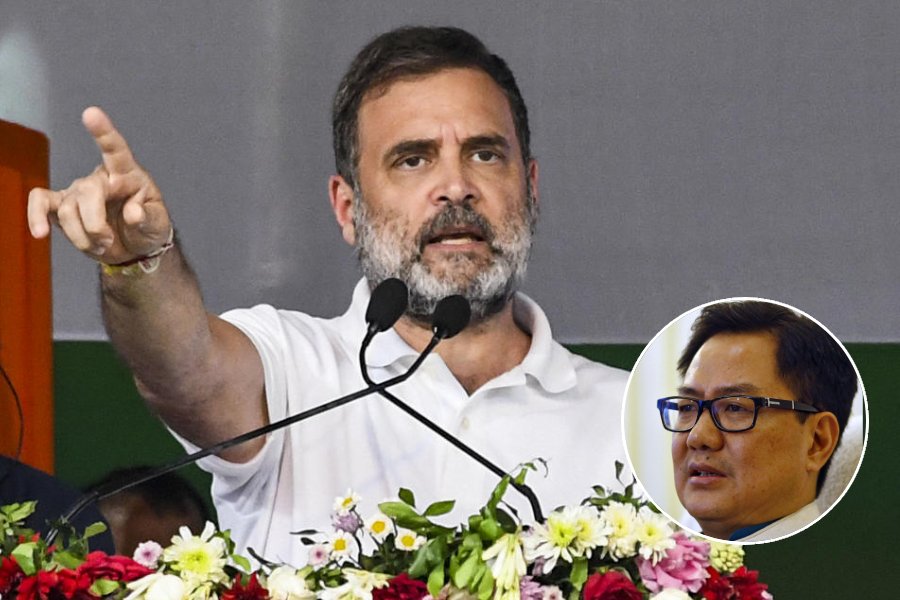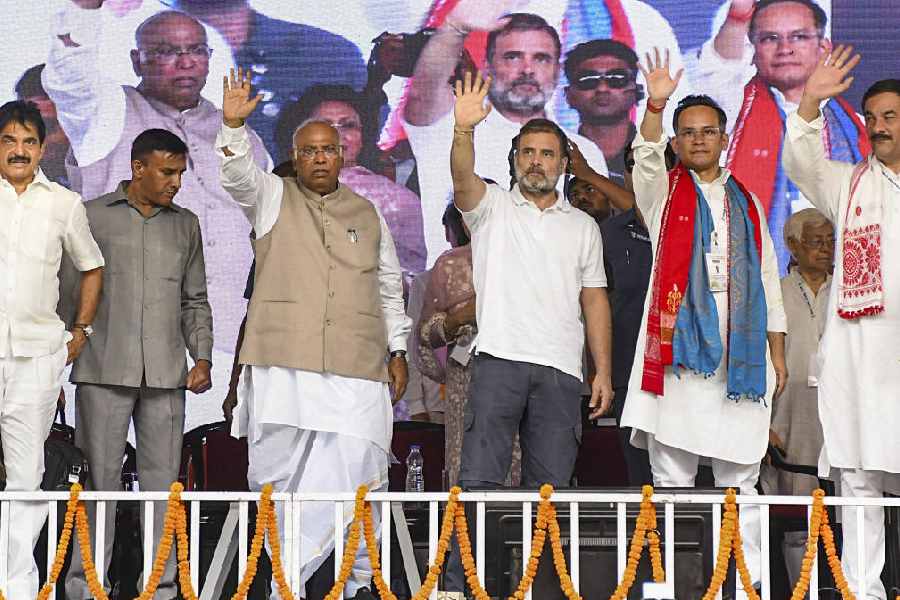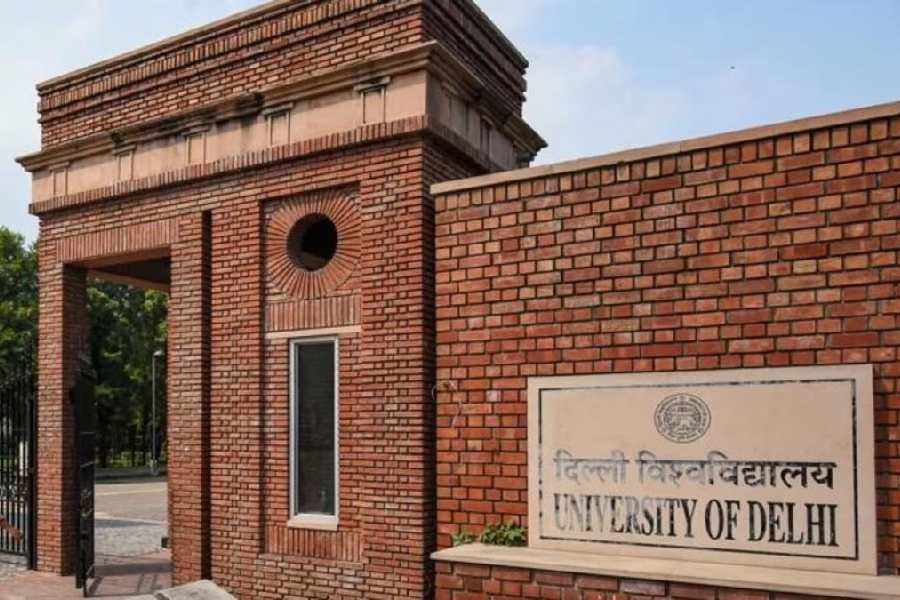India’s scientific landscape is ablaze with ideas — efforts to unravel the secrets of a 108-petal lotus, combine “cow science” with “tantra healing” for cancer, explore connections between the ancient Swastika symbol and the Vedas and modern physics.
While Indian space scientists worked on the lunar landing mission and a space-based solar observatory, others were engaged with projects focused on “cow science”, driven by religious symbolism, or were seeking to harness — some say market — ancient Indian knowledge in the 21st century.
An IIT director’s attempt to link meat-eating with natural disasters has amplified concerns among sections of scientists about what they view as the changing ethos at research institutions headed by people aligned with the cultural ideology that the Narendra Modi government represents.
A video clip circulated on social media last month featured IIT Mandi director Laxmidhar Behera addressing students.
“You are butchering them, innocent animals. That has a symbiotic relationship with the degradation of the environment… the landslides, cloudbursts you’re seeing again and again. These are all effects of this cruelty,” he said.
The talk’s context is unclear in the video. But multiple scientists in institutions across the country have said they are more worried about what Behera’s position as director of an IIT implies than his message about meat-eating.
The celebrations over the Chandrayaan-3 landing and the launch of Aditya-L1, a space-based solar observatory, over the past month have come against a backdrop of concern among some scientists about activities in scientific institutions they say they could not have imagined a decade ago.
Critics view some of these initiatives as attempts to allow pseudoscience to piggyback top institutional brands.
“There is a sense of outrage that coexists with a fear of retribution,” said Ayan Banerjee, a physics professor at the Indian Institute of Science Education and Research (IISER), Calcutta. “Therefore, almost no one questions such activities publicly.”
Some scientists believe that the activities are part of what one researcher called a “cultural metamorphosis” at some research institutions, facilitated by heads of institutions aligned with a conservative, Right-wing Hindutva ideology or those pretending to play along.
“Initially, we dismissed such things as idiosyncrasies of individuals, but their frequency is rising,” said Soumitro Banerjee, another physics professor at IISER, Calcutta, and secretary to the Breakthrough Science Society, a nationwide network of teachers that promotes the scientific temper.
“We see institutional heads patronising such ideas. Some probably sense that this is a way of attracting the attention of people in power. In this milieu, rationality, which is the hallmark of science, is taking a back seat. We cannot afford to ignore this trend.”
Subhash Lakhotia, a distinguished professor of zoology at the Banaras Hindu University, Varanasi, shares such concerns.
“It is unfortunate that some academic institutions are promoting projects that align with certain perceptions rather than being designed to ask specific questions or test a hypothesis,” he said.
Scientists involved in controversial projects have defended their activities — some explaining them as routine research efforts, others accusing their critics of trying to politicise legitimate research.
108-petalled ‘Namoh’
The National Botanical Research Institute (NBRI), Lucknow, picked a lotus flower with 108 petals for genome sequencing four years ago. NBRI director Ajit Shasany said that one reason for selecting this genotype was the “religious significance” of the number 108 to Hinduism and Buddhism.
“But this was not the only reason,” Shasany told The Telegraph. “The genotype has a high nutritional value with potassium, phosphorus, calcium and amino acids. It is a source of high-quality fibre that may be used for dress material, and we’ve created a perfume from it. This genotype can become an income-generator.”
The NBRI has named the lotus “Namoh 108”, which Union science minister Jitendra Singh last month said was a “grand gift to the relentless zeal and innate beauty of Shri Narendra Modi, coming as it does in the tenth year of his tenure as Prime Minister”.
While “namoh” means “I bow to” and is a ubiquitous word in Sanskrit prayers, it also happens to be a homophone of NaMo, an acronym for Narendra Modi.
‘Cow science’ & tantra
A conference on “cow science” organised by IIT Guwahati earlier this year accepted a paper titled “Jiva Upkara Tantra-based biosocial healing for cancer patients by implementing indigenous cow farming and whey protein production plan”.
Some of the other papers described the panchagavya — a cocktail of curd, dung, ghee, milk and urine from cows — as a potential treatment for many health disorders, including gynaecological disorders, heart disease, obesity, skin disease and leprosy.
Two IIT Guwahati faculty members and conference organisers told this newspaper in an email that “there were no tall claims made at the conference”.
The concept of Jiva Upkara Tantra practices was presented at the conference “as part of traditional knowledge”, they wrote, while asserting that claims about medicinal products from cows needed evaluation through clinical trials. “Collective scientific interventions are required to critically examine pseudoscience,” they added.
Swastika, Vedas
At IIT Kharagpur, the department of architecture and regional planning has an Office of the Concept of Complete Religion (OCCR), from where faculty and student interns have since 2016 published several reports, among them an exposition of the Swastika, touching on the symbol’s “association with the law of nature and beauty of evolution”.
Another report seeks to connect concepts from the Vedas to, among other things, the principle of “non-linearity”, a scientific idea that involves unpredictable events.
An IIT Kharagpur faculty member associated with the OCCR said that more than 20 Nobel laureates had talked about the connections between Indian knowledge systems and quantum physics.
“Post-modern science, non-linear science, quantum science, green and inclusive science are recognising the age-old wisdom of Indian knowledge systems,” said Joy Sen, a professor with IIT Kharagpur’s department of architecture and planning and chair, Centre of Excellence for Indian Knowledge Systems.
“The old order myopic, reductionist scientists need to update themselves — they need to understand the growing overlap between the inner psychic constructs of Indian cosmology in the inner meditative laboratory of mind consciousness and advances in modern physics,” Sen said, when asked to respond to concerns expressed by fellow scientists.
Spirituality in medicine
The All India Institute of Medical Sciences (AIIMS), New Delhi, has in recent months invited its faculty and students to join talks titled “Medical science and Indian scriptures,” “Hope, healing, and health,” and “Indian values and spirituality in medicine.”
“Such developments are saddening — they suggest that considerations of scientific rigour, scientific temper and ethics don’t figure any more in important appointments in scientific institutions,” said Gautam Menon, professor of physics and biology and dean at Ashoka University, Sonipat.
However, some say that inadequacies in science education predating the Modi government have contributed to the current state of affairs.
“Our education system teaches science but doesn’t tell students how science works,” Soumitro Banerjee said. “A student is never told that the central dogma in science is: don’t believe anything unless there is evidence.”
Others have challenged suggestions that the appointments of institutional heads now reflect a substantial change from past practices.
“Mediocrity and favouritism weren’t invented in 2014,” said Rahul Siddharthan, a computational biophysicist at the Indian Institute of Mathematical Sciences, Chennai.
Aniket Sule, an astrophysicist at the Homi Bhabha Centre for Science Education, Mumbai, believes there is another factor in play that could account for the current trends.
"Genuine scientists are unlikely to be aligned to any (dogmatic) ideology," Sule said. Earlier, when ideology was irrelevant, even assuming that favouritism was at work, the choice of candidates was broad. "But if you are looking for people with a certain ideology, you’ll need to scrape the bottom," Sule said.










